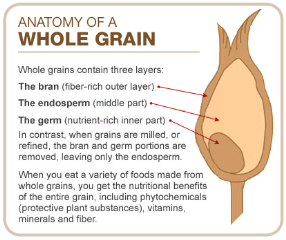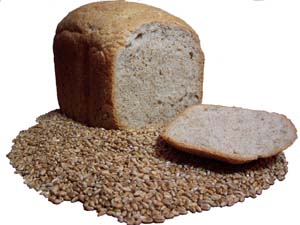While you’re in the store doing your grocery shopping, you go down the aisle and notice the words refined, enriched, and whole-grain written on grain products. These words describe the milling and making process of grain products and each term has different nutrition implications.
Let’s break it down.
Grains have three different key parts:
- Bran- outer protective coating, which is rich in fiber and nutrients
- Germ- seed that grows into a wheat plant, so it’s especially rich in vitamins and minerals to support new life
- Endosperm- contains starch and proteins

Quick definitions:
- Refined- foods lose many nutrients during processing
- Enriched- products have had some nutrients added back
- Whole grain- products that are rich in fiber and all nutrients found in the original grain
What makes whole-grain products so nutritious is that they contain much of the bran, germ, and the endosperm. The difference between white and wheat flour is significant – white bread is wheat bread stripped of all its naturally occurring nutrients. Whole grains haven’t had the bran and germ removed by milling, making them better sources of fiber. Whereas refined grains (white rice or flour) contain only the endosperm because they are stripped of the bran and germ. These items are then enriched by adding vitamins and minerals back after the milling process, but they still don’t have the nutritional value or the fiber that whole grains contain.
It is recommended that at least ½ of the grain products you eat be whole-grain (common range is 3-5 servings). When purchasing these items, the word whole-grain needs to be listed first or second on the ingredients list. On the ingredient list, if whole-wheat flour is followed by enriched flour, niacin, and iron then it’s not the healthiest choice. This is confusing because it is whole wheat, but it is not whole-grain – it came from the wheat plant and it’s all wheat, but not all grain.
*Meaning, whole-wheat options are a good choice, especially over white/enriched grains, but whole-grain products are the best and healthiest option.

What counts as a serving?
- a half cup of cooked brown rice, whole-grain pasta, or other cooked whole-grains
- a cup of 100% whole-grain cold cereal
- a slice of 100% whole-grain bread
- a product containing at least 16 grams of whole-grain ingredients
Along with fruits and vegetables, whole-grain products provide disease-fighting fiber, antioxidants, and phytochemicals as well as B vitamins, vitamin E, magnesium, and iron. Whole-grains have been proven to reduce the risks of obesity, diabetes, cancer, stroke, and heart disease. Also, fiber is great with weight loss and maintenance because a high-fiber diet tends to make a meal more filling so you stay full for a longer amount of time; therefore you eat less and take in fewer calories.

Great info. Thanks!
its nice information, I hope theres more that you would share… thanks a lot…
wondering why refined bread is suggested for someone with diviticuolisis as being good for them